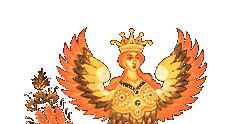Antonina Ivanova was born in Borovsk in the Kaluga Region of Russia. She studied at teh Palekh Art School from 1966-1971, and has worked at the Palekh Art Works since her gradution. She became a member of the Artists Union in 1989. Themes of her work include folklore, literature, genre scenes, and more, with such titles as "On the Seashore", "Autumn", and "Tale of Tsar Saltan". Her works are on display in the State Museum of Palekh Art, the All-Russia Museum of Decorative and Applied Art, and the Art Foundation of Russia.
The following is from an interview with Antonina Ivanova:
"I like Golikov, but to adopt his ideas is rather difficult... I simply enjoy him. Markichev is close to me, and I love Zinovyev's "Humpbacked Pony". In my opinion, the main things a painter should possess are talent and diligence. And even more so, steadfastness to an ideal. In Palekh, this means showing kindness and love and serving beauty, without which a human being cannot live. This is enternal. I greatly appreciate in an artist integrity and an honest, uncompromising approach to art. There may be hard times in one's life, there may be temptation, but one should never give up. The relationship between commerce and art is a difficult and unnatural one. Commerce demoralizes art from within.
"Ideas come in different ways. Sometimes you see something of interest in life around you, come across something in your reading or an idea flashes through your mind while you are contemplating a work of one of your favourite artists. The important thing is that life feeds them. A picture may come in dream and take hold of you and you are both glad, happy, and fearful all at the same time: will you be able to express what you dreamed and unfalteringly in the language of Palekh traditions? Trying to find a way of expressing an idea can be a torturous process. You wish to share excitement and happiness you feel with others, but the painting develops slowly, ploddingly. Into the early hours of the morning you sit working away at your table. In the morning Irina Livanova may call on you and if she approves of your efforts, you are overjoyed; if not, you clean the picture off and start anew. You may become nervous and burst into tears but never mind and do not lose your temper. There is nothing to be done but keep on working. When it is finished you still do not feel satisfied as everything could be done otherwise, both the composition and colors. You become greater than your former self through your work. What is left in the end is hope that next time..."
Information on this artist and her works can be found in these books:
I. Feoktistova T.Ye, 1999, PALEKH ON THE THRESHOLD OF THE THIRD MILLENIUM. To Mark the 75th anniversary of Palekh Lacquer Miniatures, OGI, Moscow:
1. A. Ivanova's biography is sited at page 309.
II. Pirogova L., 1994, PALEKH HISTORY AND MODERN TIME, ISKUSSTVO, ROSKNIGA, Moscow, ISBN 5-210-01301-4:
1. Box "A fairy-tale" (1980), page 111.
2. A. Ivanova's biography is sited at pages 183, 194.
III. Bratchikova Ye. K., 1996, MINIATURISTS OF PALEKH. NAME REFERENCE, RUSSLIT, Moscow, ISBN 5-7739-0001-7, ISBN 5-86508-035-0:
1. A. Ivanova's biography is sited at page 54.
IV. Shchanitsyn Vadim, 1994, PALEKH AND PALEKHIANS, INDUSTRIAL COMPANY "ZET", Moscow:
1. A. Ivanova's biography is sited at page 24.
2. Box "Morning" (1987), page 83.
3. Box "Morozko" (1990), page 92.
Reference: page 194 of  Pirogova L., 1994, "PALEKH HISTORY AND MODERN TIME", ISKUSSTVO, ROSKNIGA, Moscow, ISBN 5-210-01301-4 Pirogova L., 1994, "PALEKH HISTORY AND MODERN TIME", ISKUSSTVO, ROSKNIGA, Moscow, ISBN 5-210-01301-4
|



